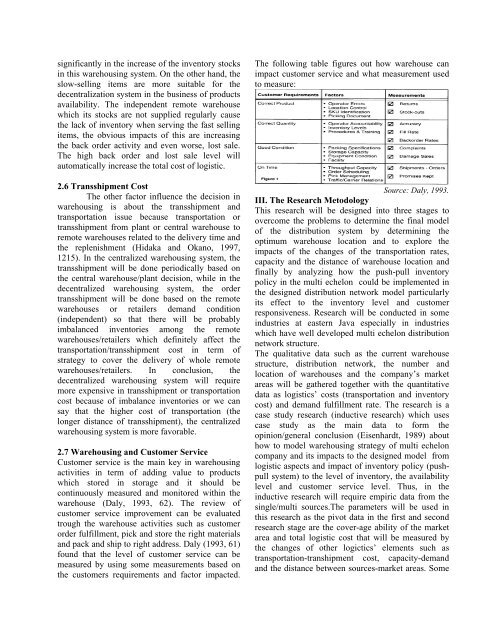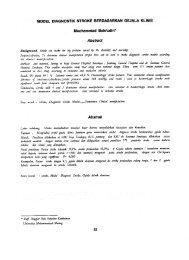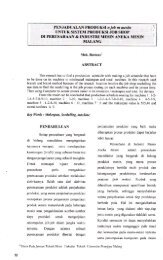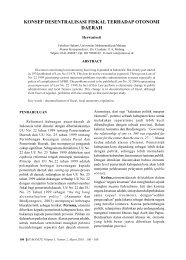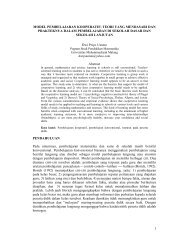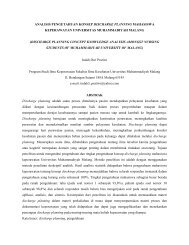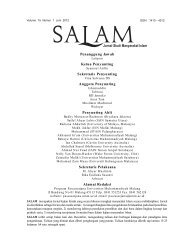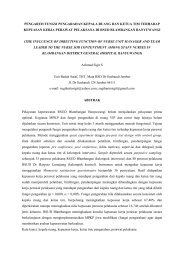Modeling Warehousing System to Improve Customer ...
Modeling Warehousing System to Improve Customer ...
Modeling Warehousing System to Improve Customer ...
You also want an ePaper? Increase the reach of your titles
YUMPU automatically turns print PDFs into web optimized ePapers that Google loves.
significantly in the increase of the inven<strong>to</strong>ry s<strong>to</strong>cks<br />
in this warehousing system. On the other hand, the<br />
slow-selling items are more suitable for the<br />
decentralization system in the business of products<br />
availability. The independent remote warehouse<br />
which its s<strong>to</strong>cks are not supplied regularly cause<br />
the lack of inven<strong>to</strong>ry when serving the fast selling<br />
items, the obvious impacts of this are increasing<br />
the back order activity and even worse, lost sale.<br />
The high back order and lost sale level will<br />
au<strong>to</strong>matically increase the <strong>to</strong>tal cost of logistic.<br />
2.6 Transshipment Cost<br />
The other fac<strong>to</strong>r influence the decision in<br />
warehousing is about the transshipment and<br />
transportation issue because transportation or<br />
transshipment from plant or central warehouse <strong>to</strong><br />
remote warehouses related <strong>to</strong> the delivery time and<br />
the replenishment (Hidaka and Okano, 1997,<br />
1215). In the centralized warehousing system, the<br />
transshipment will be done periodically based on<br />
the central warehouse/plant decision, while in the<br />
decentralized warehousing system, the order<br />
transshipment will be done based on the remote<br />
warehouses or retailers demand condition<br />
(independent) so that there will be probably<br />
imbalanced inven<strong>to</strong>ries among the remote<br />
warehouses/retailers which definitely affect the<br />
transportation/transshipment cost in term of<br />
strategy <strong>to</strong> cover the delivery of whole remote<br />
warehouses/retailers. In conclusion, the<br />
decentralized warehousing system will require<br />
more expensive in transshipment or transportation<br />
cost because of imbalance inven<strong>to</strong>ries or we can<br />
say that the higher cost of transportation (the<br />
longer distance of transshipment), the centralized<br />
warehousing system is more favorable.<br />
2.7 <strong>Warehousing</strong> and Cus<strong>to</strong>mer Service<br />
Cus<strong>to</strong>mer service is the main key in warehousing<br />
activities in term of adding value <strong>to</strong> products<br />
which s<strong>to</strong>red in s<strong>to</strong>rage and it should be<br />
continuously measured and moni<strong>to</strong>red within the<br />
warehouse (Daly, 1993, 62). The review of<br />
cus<strong>to</strong>mer service improvement can be evaluated<br />
trough the warehouse activities such as cus<strong>to</strong>mer<br />
order fulfillment, pick and s<strong>to</strong>re the right materials<br />
and pack and ship <strong>to</strong> right address. Daly (1993, 61)<br />
found that the level of cus<strong>to</strong>mer service can be<br />
measured by using some measurements based on<br />
the cus<strong>to</strong>mers requirements and fac<strong>to</strong>r impacted.<br />
The following table figures out how warehouse can<br />
impact cus<strong>to</strong>mer service and what measurement used<br />
<strong>to</strong> measure:<br />
Source: Daly, 1993.<br />
III. The Research Me<strong>to</strong>dology<br />
This research will be designed in<strong>to</strong> three stages <strong>to</strong><br />
overcome the problems <strong>to</strong> determine the final model<br />
of the distribution system by determining the<br />
optimum warehouse location and <strong>to</strong> explore the<br />
impacts of the changes of the transportation rates,<br />
capacity and the distance of warehouse location and<br />
finally by analyzing how the push-pull inven<strong>to</strong>ry<br />
policy in the multi echelon could be implemented in<br />
the designed distribution network model particularly<br />
its effect <strong>to</strong> the inven<strong>to</strong>ry level and cus<strong>to</strong>mer<br />
responsiveness. Research will be conducted in some<br />
industries at eastern Java especially in industries<br />
which have well developed multi echelon distribution<br />
network structure.<br />
The qualitative data such as the current warehouse<br />
structure, distribution network, the number and<br />
location of warehouses and the company’s market<br />
areas will be gathered <strong>to</strong>gether with the quantitative<br />
data as logistics’ costs (transportation and inven<strong>to</strong>ry<br />
cost) and demand fulfillment rate. The research is a<br />
case study research (inductive research) which uses<br />
case study as the main data <strong>to</strong> form the<br />
opinion/general conclusion (Eisenhardt, 1989) about<br />
how <strong>to</strong> model warehousing strategy of multi echelon<br />
company and its impacts <strong>to</strong> the designed model from<br />
logistic aspects and impact of inven<strong>to</strong>ry policy (pushpull<br />
system) <strong>to</strong> the level of inven<strong>to</strong>ry, the availability<br />
level and cus<strong>to</strong>mer service level. Thus, in the<br />
inductive research will require empiric data from the<br />
single/multi sources.The parameters will be used in<br />
this research as the pivot data in the first and second<br />
research stage are the cover-age ability of the market<br />
area and <strong>to</strong>tal logistic cost that will be measured by<br />
the changes of other logictics’ elements such as<br />
transportation-transhipment cost, capacity-demand<br />
and the distance between sources-market areas. Some


